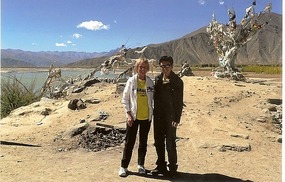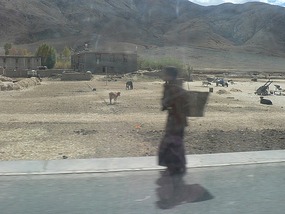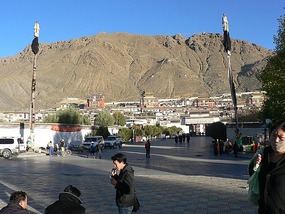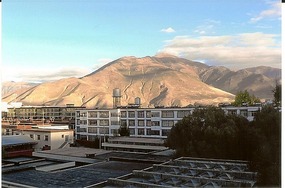Beetling along in Mr Yu's comfortable Hyundai van with the DVD on full blast playing modern Tibetan music was a most pleasurable way to take in the ever changing scenery of rural Tibet. Not that we could understand a word of what was sung but it went along the lines of 'Whoahhhhhooooooo, Whoahhhhhooooooo..." Lochoe told us that the singer was very famous in Tibet and we liked it too. We love travel by road or by rail. But we would have to say that road travel was much more convenient for us in Tibet. At least we had some, if a rather small, semblance of control over stops to view the scenery or more importantly, for bladder relief.
Poor Lochoe was becoming a bit frustrated with our frequent stops for bladder mercy, exacerbated of course by our quaffing down of several beers wherever we stopped for meals. Local beer was very good. In the end Lochoe just ignored our requests for stops. And in the end we twigged that Lochoe's English for toilet stops was "Pee, pee". Yelled loudly enough, we eventually got our way.
The trip from from Gyantse to Shigatse was once again through intense farming land with heavy crops of barley and wheat being harvested by hand or by donkey drawn harvesters. Everyone seemed to be helping with the harvest and the countryside and roads were alive with people of all ages, driving donkey carts or carrying baskets of grain.
It appeared all very casual, with goats, sheep and people mingling around village centres or meandering along or across the roadsides. Shigatse is only 95 kms from Gyanste and we arrived comfortably in the early afternoon.
The second largest city in Tibet with a population of 80,000, Shigatse (official spelling Xigaze) is located at an altitude of 3,830 meters in western Tibet and is the hub of a road network between Lhasa, Nepal and the western Tibetan region. Shigatse is the administrative centre of modern Xigaze County, Xigaze Prefecture and is the traditional home of the "Tashi" or Panchen Lamas. The city houses a large number of monasteries, the most famous being the magnificent gold and red Tashilhunpo Monastery. Built in 1447 this monastery is home to the well known Yellow Sect monks and the world's largest bronze statue of the Qianba Buddha.
By this time, we were beginning to tire of monastery visits. This was certainly no criticism of the tour or of our ever patient guide Lochoe - but we were in rather information and sightseeing overload. This of course happens to most tourists. On the second day, we had a free afternoon where we thoroughly enjoyed taking in the bustling atmosphere of what appeared to be a prosperous thriving rural city.
Our hotel was pleasant and comfortable and at last we had a place where we could organise some laundry. Our clothes were looking pretty ordinary after days of travel through dusty deserts and rural farming areas. The restaurant however was more like a military food hall and although we were not part of a large tour group we were herded into long tables with masses of other tourists. It sure lacked any atmosphere.
By day two in Shigatse, Alan was feeling somewhat tired and emotional. At breakfast he was disappointed that there were no fried eggs, then threw a complete "wobbly" when he couldn't peel his boiled one. Even worse, on the way out the waiters were bringing in large platters of freshly fried eggs.... We laughed (eventually) that when you are tired such small things really try out your patience. And mostly it was totally unjustifiable.
We were also becoming concerned about our coming trip in far west China from Kashgar to Tashkorgan. We knew that the Karakoram Highway from Kashgar to Tashkorgan can be closed early due to inclement weather with accompanying snow and rock slides. We could not contact our hotel in Tashkorgan and feared our trip could be cancelled. On the last morning in Shigatse we met up again with our English tour friends Sam and Anne Cowan and their friendly and helpful guide Tashi Tenzing. Tashi could not help us with our questions about the journey to Tashkorgan but he was unbelievably helpful with my rather embarrassing request for a written translation for "laxatives". I still have it written in Mandarin for future trips - just in case. Thank you Tashi!
Tashi was interested to hear where we were from. We gave our usual rough description of a fishing village sort of half way between Sydney and Brisbane. He then asked us to be more specific. When we told him our nearest town was Taree he sighed "Ah yes, I know Taree well - it's where all the cows are". As it turns out Tashi is an Australian citizen and lived in Australia for 15 years. A small world.
We have kept up our contact with the Cowans and with Tashi. We were fascinated to hear that he is indeed the grandson of the famous Norgay Tenzing of Mount Everest fame. Tashi is himself an internationally renowned mountain climber and is a multiple summit climber of Everest. He currently runs a mountaineering travel company out of Kathmandu, Nepal www.tashitenzingasiantours.
I often groaned later that my only brush with fame in Tibet was because I was desperate for advice on how I could purchase laxatives.....
More of Rural Tibet - Our Trip to Shigatse
Tuesday, October 16, 2007
 Shigatse, Tibet, China
Shigatse, Tibet, China
Other Entries
-
1From Crowdy Head to Sydney - Our Journey Begins
Oct 0610 days prior Crowdy Head, Australiaphoto_camera0videocam 0comment 0
Crowdy Head, Australiaphoto_camera0videocam 0comment 0 -
2On the Eve - Our Journey to the Distant Chinas
Oct 079 days prior Sydney, Australiaphoto_camera2videocam 0comment 0
Sydney, Australiaphoto_camera2videocam 0comment 0 -
3A Brief Return to Our Favourite City of Shanghai
Oct 088 days prior Shanghai, Chinaphoto_camera5videocam 0comment 0
Shanghai, Chinaphoto_camera5videocam 0comment 0 -
4Our Journey to Zhongdian, via Kunming
Oct 097 days prior Kunming, Chinaphoto_camera2videocam 0comment 0
Kunming, Chinaphoto_camera2videocam 0comment 0 -
5Two Delightful Days in Shangri-la - "Paradise"
Oct 106 days prior Zhongdian, Chinaphoto_camera8videocam 0comment 0
Zhongdian, Chinaphoto_camera8videocam 0comment 0 -
6Mystical Lhasa
Oct 115 days prior Lhasa, Chinaphoto_camera8videocam 0comment 0
Lhasa, Chinaphoto_camera8videocam 0comment 0 -
7Friendly and Not so "Ho-Hum" Tsedang
Oct 133 days prior Tsedang, Chinaphoto_camera16videocam 0comment 0
Tsedang, Chinaphoto_camera16videocam 0comment 0 -
8Rural Tibet - Our Desert Journey to Gyantse
Oct 151 day prior Gyantse, Chinaphoto_camera19videocam 0comment 0
Gyantse, Chinaphoto_camera19videocam 0comment 0 -
9More of Rural Tibet - Our Trip to Shigatse
Oct 16 Shigatse, Chinaphoto_camera4videocam 0comment 0
Shigatse, Chinaphoto_camera4videocam 0comment 0 -
10Returning to Lhasa
Oct 182 days later Lhasa, Chinaphoto_camera4videocam 0comment 0
Lhasa, Chinaphoto_camera4videocam 0comment 0 -
11Aboard the Lhasa Express - Lhasa to Golmud
Oct 193 days later Golmud, Chinaphoto_camera18videocam 0comment 0
Golmud, Chinaphoto_camera18videocam 0comment 0 -
12Salt Pans, Altun Shan and a Taklamakan Apparition
Oct 204 days later Dunhuang, Chinaphoto_camera6videocam 0comment 0
Dunhuang, Chinaphoto_camera6videocam 0comment 0 -
13Lovely Dunhuang - An Oasis in the Gobi Desert
Oct 226 days later Dunhuang, Chinaphoto_camera16videocam 0comment 0
Dunhuang, Chinaphoto_camera16videocam 0comment 0 -
14Frenetic Liuyuan and our Rail Trip to Turpan
Oct 237 days later Turpan, Chinaphoto_camera0videocam 0comment 0
Turpan, Chinaphoto_camera0videocam 0comment 0 -
15Toward Turpan - Our Welcome to Xinjiang Province!
Oct 248 days later Turpan, Chinaphoto_camera2videocam 0comment 0
Turpan, Chinaphoto_camera2videocam 0comment 0 -
16Tales of Turpan - Second Lowest Basin in the World
Oct 248 days later Turpan, Chinaphoto_camera11videocam 0comment 0
Turpan, Chinaphoto_camera11videocam 0comment 0 -
17Exotic Urumqi - As Far From the Sea as You Can Be
Oct 2610 days later Ürümqi, Chinaphoto_camera7videocam 0comment 0
Ürümqi, Chinaphoto_camera7videocam 0comment 0 -
18Twenty Three Hours to Kashgar by Rail
Oct 2812 days later Kashgar, Chinaphoto_camera0videocam 0comment 0
Kashgar, Chinaphoto_camera0videocam 0comment 0 -
19Our Introduction to the Frontier City of Kashgar
Oct 2913 days later Kashgar, Chinaphoto_camera4videocam 0comment 0
Kashgar, Chinaphoto_camera4videocam 0comment 0 -
20A Driver Called Mukhtar - Travels to Tashkorgan
Oct 3014 days later Tashkorgan, Chinaphoto_camera14videocam 0comment 0
Tashkorgan, Chinaphoto_camera14videocam 0comment 0 -
21Kashgar Old City, More Carpets and Abdul Karim
Oct 3115 days later Kashgar, Chinaphoto_camera7videocam 0comment 0
Kashgar, Chinaphoto_camera7videocam 0comment 0 -
22On the Home Run - From Kashgar Back to Urumqi
Nov 0217 days later Ürümqi, Chinaphoto_camera4videocam 0comment 0
Ürümqi, Chinaphoto_camera4videocam 0comment 0 -
23From Urumqi to Shanghai, Sydney and Home
Nov 0419 days later Shanghai, Chinaphoto_camera1videocam 0comment 0
Shanghai, Chinaphoto_camera1videocam 0comment 0 -
24Home In Crowdy Head and A Message to Our Readers
Nov 0520 days later Crowdy Head, Australiaphoto_camera0videocam 0comment 0
Crowdy Head, Australiaphoto_camera0videocam 0comment 0

 Shigatse, Tibet, China
Shigatse, Tibet, China





2025-05-23